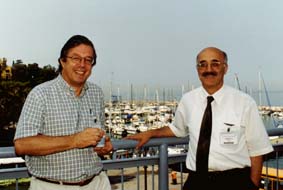Personal tools
News from ICTP 106 - Profile

Nearly 20 years ago, two Trieste-based scientists provided the scientific underpinning for computer simulation, setting the stage for the modelling revolution that followed.
Models of Behaviour

Roberto Car and Michele Parrinello
In the modern BC (before the
computer) world of science, all of science, but particularly physics,
could be neatly divided into two categories: theoretical and experimental.
Over the past two decades, however, computer simulation and modelling--a
hybrid of theory and experiment or, more precisely, an intricate
blend of theory and experiment in which it is difficult to separate
one from the other--has emerged as one of the primary ingredients
of modern scientific inquiry. Indeed some researchers now contend
that computer simulation and modelling represents a third way
of doing science.
One of the most noteworthy advancements in this field took place
in Trieste during the 1980s when two Italian physicists, Roberto
Car and Michele Parrinello, conducted research at the International
School for Advanced Studies (SISSA), next door to ICTP, and at
ICTP, on the ab-initio molecular dynamics method, an analytical
method that has since assumed the names of its discoverers: the
Car-Parrinello method.
The article that they coauthored, "Unified Approach for Molecular
Dynamics and Density-Functional Theory," published in Physical
Review Letters (22-25 November 1985), remains the fifth most
cited article of the publication--with a total of 3,000 citations
and counting. For their work, Car and Parrinello shared the 1990
Europhysics Prize of the European Physical Society.
Born in Trieste and educated at Politecnico di Milano,
Italy, Roberto Car is currently professor in the Chemistry Department
at Princeton University, New Jersey, USA. Michele Parrinello,
who was born in Messina, Sicily, is now professor of computational
science at the Laboratory of Physical Chemistry of the Eidgenossische
Technische Hochschule Zürich (ETH, Swiss Federal Institute
of Technology) in Lugano, Switzerland.
The Car-Parrinello method helped to launch a new era of understanding
in the esoteric field of electronic structure calculations for
solids, liquids and molecules. While the concept may be difficult
to understand, it has had an enormous impact in the creation of
molecular simulations that have had useful applications in all
the basic sciences.
Car and Parrinello, then both in their early 40s, first met in
Trieste in 1984 through their affiliation with SISSA and ICTP,
which have always promoted inter-institutional interaction between
their staff and visiting scientists.
"We hit it off immediately and soon talked about the possibility
of working together," says Parrinello. "Roberto was
deeply involved in studies on how to improve the electronic structure
of crystals, while I had a strong background in statistical mechanics
and molecular biology. We thought it could be interesting to combine
our expertise."
"At the time, the challenges posed by silicon, particularly
liquid silicon, were among the hottest topics in the field of
condensed matter physics. Researchers knew, from experimentation,
that silicon changes from a semiconductor to a metallic phase
when you melt it. But no one could satisfactorily explain how
this transition took place. It was an unanswered challenge that
we thought we could make a contribution to, through our varied
and complementary skills."
The twosome, often working at night when computer capacity was
most available, conducted their research and wrote their paper
over several months in the winter of 1984. The article, after
a series of minor revisions, was published in Physical Review
Letters several months later.
"It was an extraordinary time," Parrinello recalls.
"I think that, regardless of your profession, it is always
important to be in the right place at the right time--and that
certainly was the case for Roberto and me in Trieste in the mid
1980s. We later went our separate ways, but we both look back
on those years with fondness, especially when meeting on occasions
in Trieste."
In recent years, Car has used his expertise to pursue such research
topics as modelling electronic current in nanostructures. "But
I still benefit from the collaboration with Michele. The way we
approached the problem--through what was then the new field of
computer simulation--has given me both a practical tool and lofty
inspiration for my subsequent research."
The Car-Parrinello model is now a standard analytical concept
not only in condensed matter physics, but in other disciplines
as well. Parrinello, for example, is currently interested in the
behaviour of water, whose study involves biophysics, biochemistry
and, yes, sophisticated computer simulation.
"Even today," Parrinello says, "many of my colleagues
insist that computing simulation fails to represent the real world
and, as a result, real problems cannot be addressed by such a
methodology."
"I agree that computing is no substitute for thinking. But
computer simulation has proven useful in so many studies that
the verdict should no longer be in dispute: There is overwhelming
evidence in favour of using such an approach for both broadening
and deepening our scientific understanding of an increasing number
of problems. Simulation is here to stay."